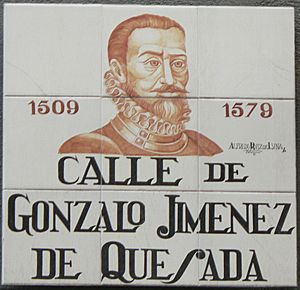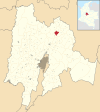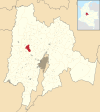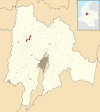Hernán Pérez de Quesada facts for kids
Quick facts for kids
Hernán Pérez de Quesada
|
|
|---|---|
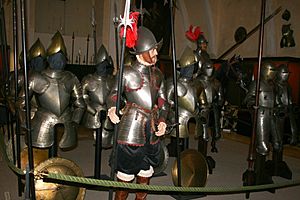
Hernán, as Spanish conquistador,
wore an armoured uniform |
|
| Born | c. 1500 |
| Died | 1544 |
| Cause of death | Lightning strike |
| Nationality | Castilian |
| Occupation | Conquistador |
| Years active | 1536–1542 |
| Employer | Spanish Crown |
| Known for | Spanish conquest of the Muisca Quest for El Dorado |
| Title | Governor of New Kingdom of Granada |
| Term | 1539–1542 |
| Predecessor | Gonzalo Jiménez de Quesada (1538–1539) |
| Successor | Luis Alonso de Lugo (1542–1544) |
| Criminal charge(s) | • Mistreatment of indigenous people • Murders of Tisquesusa, Sagipa & Aquiminzaque |
| Parents |
|
| Relatives | Gonzalo Jiménez (brother) Francisco Jiménez (brother) Melchor Jiménez (brother) Andrea Ximénez (sister) Catalina Magdalena (sister) Isabel de Quesada (half-sister) |
| Notes | |
Hernán Pérez de Quesada (born around 1500, died 1544) was a Spanish conquistador. A conquistador was a Spanish explorer and soldier. They traveled to the Americas in the 1500s. Hernán was the second-in-command. He served under his older brother, Gonzalo Jiménez de Quesada.
Hernán was part of the first European trip. This journey explored the inner highlands of the Colombian Andes. The trip was very difficult and lasted almost a year. Many people died during this expedition. It went through areas that are now Magdalena, Cesar, Santander, Boyacá, Cundinamarca, and Huila. These are all in modern-day Colombia. This first part of the journey happened between 1536 and 1539. Later, from 1540 to 1542, Hernán explored other parts of Colombia. These included Meta, Caquetá, and Putumayo. He also traveled to northern Peru and Ecuador.
Hernán helped found the town of Sutatausa in Cundinamarca. He also took part in conquering several indigenous groups. These groups included the Chimila, Muisca, Panche, Lache, U'wa, and Sutagao. Sadly, under Hernán's command, the last Muisca ruler, zaque Aquiminzaque, was executed. Other Muisca leaders, like zipas Tisquesusa and Sagipa, and Tundama of Duitama, had also been executed earlier.
After his expeditions, Hernán went south to Quito. There, he met his younger brother Francisco. Both brothers then returned to Bogotá. In Bogotá, Hernán was arrested. He was accused of mistreating indigenous people. He was also accused of causing the deaths of Muisca rulers. In 1544, Hernán and Francisco were sailing back to Spain. Their ship was struck by lightning. This happened off the coast of Cabo de la Vela in the Caribbean Sea. Both brothers died in the lightning strike. Several other conquistadors on the ship were injured.
We know about Hernán Pérez de Quesada from his brother Gonzalo. Also, historians like Pedro de Aguado, Juan Freyle, Lucas Fernández de Piedrahita, Joaquín Acosta, and Liborio Zerda wrote about him.
Contents
Hernán Pérez de Quesada: His Life and Adventures
Early Life and Family
Hernán Pérez de Quesada was born around the year 1500. His birthplace was Granada, a city in Andalusia, Spain. He was the second son of Luís Jiménez de Quesada and Isabel de Rivera Quesada. His family was Catholic.
Hernán had an older brother named Gonzalo Jiménez. Gonzalo also became a famous conquistador. Hernán had three other brothers: Melchor, Francisco, and Andrea. Francisco was also a conquistador, but he explored in Peru. Hernán had two sisters, Magdalena and Catalina. He also had a half-sister named Isabel. In 1535, Hernán, Gonzalo, and Francisco sailed from Spain. They arrived in Santa Marta in early 1536. Santa Marta was the first city founded in Colombia. Rodrigo de Bastidas founded it in 1525.
The Spanish Conquest in Colombia
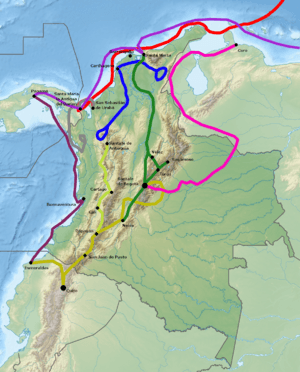
The Difficult Journey to Muisca Territory (1536-1538)
The first indigenous group the Spanish met were the Tairona. They lived around Santa Marta. Today, their descendants live in the Sierra Nevada de Santa Marta. On April 6, 1536, Gonzalo Jiménez de Quesada began an expedition. He had heard stories of a mythical "City of Gold" called El Dorado. Gonzalo organized two groups of conquistadors. They aimed for the inner highlands of the Colombian Andes.
One group, with the De Quesada brothers, traveled by land. It had over 700 soldiers and 80 horses. The other group, with over 200 men, traveled by boat. They went up the Magdalena River from Ciénaga. They were looking for the river's source. Gonzalo led the land army, with Hernán as his second-in-command. The first indigenous group they encountered was the Chimila people. As they continued south, the troops faced tough land. They crossed many creeks. Some supplies and equipment were lost while crossing the Ariguaní River.
The expedition stopped in Chía. They spent Holy Week there. In April 1537, Hernán's brother Gonzalo ordered his men to Funza. Funza was the home of the zipa, a Muisca leader. The De Quesada army was now only 170 men. But the Muisca warriors could not stand against their stronger weapons. The Muisca were defeated. Meanwhile, zipa Tisquesusa sent messages. He told other Muisca leaders about the arrival of the light-skinned, heavily armed men. The Muisca leaders thought the invaders were sacred. They did not dare to attack them. Funza was conquered on April 20, 1537. Out of over 900 soldiers who left Santa Marta, only 162 survived the hard journey.
On June 24, 1537, Hernán founded Sutatausa. This was the same day his brother Gonzalo founded Tenza.
Hernán's First Conquests
| Name | Department | Date | Year | Notes | Map |
|---|---|---|---|---|---|
| Sutatausa | Cundinamarca | 24 June | 1537 |
Founding Bogotá and Nearby Areas (1538)
By early 1538, the troops were very tired. They had been in a foreign land for almost two years. The soldiers asked for their payment for the conquest. De Quesada shared the treasures they had found. This included 40,000 pieces of fine gold and 562 emeralds. Foot soldiers received 520 pieces each. Horse riders got double that amount. Captains received 2080 pieces, and generals 3640. Some pieces were given as prizes to the bravest soldiers.
De Quesada heard about other conquistador groups. Nikolaus Federmann was coming from the east, from what is now Venezuela. Sebastián de Belalcázar was coming from the south, from Quito. Gonzalo sent Hernán to meet the southern group. They had traveled through the hot valley of Neiva. Hernán ordered the execution of Aquiminzaque. Aquiminzaque was the last zaque of Hunza. This happened in late 1538.
The Founding of Bogotá
About a year and a half after the Spanish victory over Tisquesusa, Bogotá was founded. This happened in the area of Teusaquillo. The most common date for its founding is August 6, 1538. Some historians say it was April 27, 1539. The city was started by building 12 houses made of reed. These houses represented the Twelve Apostles. A simple church, also made of reed, was built. Father Juan de las Casas held the first mass there.
The city was named Santafé de Bogotá. This name combined the Spanish city of Santa Fe with the Chibcha name of the southern Muisca capital, Bacatá. Bacatá meant "Enclosure outside of the farmfields". The new land became part of the Spanish Empire. It was called New Kingdom of Granada. This name honored the birthplace of the De Quesada brothers in Andalusia.
Leaders Return to Spain
The three main leaders of the conquest expeditions met. These were Gonzalo de Quesada, Nikolaus Federmann, and Sebastián de Belalcázar. They met in Bosa. They decided to go back to Spain. They wanted to ask the Spanish Crown for rewards for their explorations. Gonzalo made Hernán the temporary governor of the New Kingdom. He also chose the first mayor and council for Bogotá. Most of the soldiers from Federmann's and De Belalcázar's groups stayed in Bogotá. They joined De Quesada's troops. In mid-May 1539, Gonzalo Jiménez de Quesada returned to the Caribbean coast. He sailed to Spain from Cartagena. He had not found El Dorado.
Hernán Governs the New Kingdom of Granada
Expeditions and Discoveries (1540–1541)
Hernán continued his search for El Dorado. He explored the areas of Tolima and Huila. Many explorers were looking for El Dorado. After the Sun Temple in Sogamoso was destroyed in September 1537, Hernán thought there was another big place. He believed indigenous people hid their gold there. He called it "La Casa del Sol" (The House of the Sun).
He started his search from Sogamoso. He went along the right banks of the Chicamocha River. With about a hundred men, he entered the land of the Lache. They reached Jericó, which was then called Cheva. There, he and his troops took food from the original inhabitants. The people quickly fled to Chita.
The city of Tunja was founded in 1541. It was founded by Gonzalo Suárez Rendón. Hernán de Quesada had ordered this expedition. In July 1541, the leaders in Tunja told De Quesada he could not leave his territory alone. Hernán replied that everything he did was for the good of the Spanish Crown.
Later in 1541, Hernán Pérez de Quesada went north. He traveled towards what is now Norte de Santander. He crossed Panqueba, Guacamayas, El Cocuy, and Chita. He reached Chinácota but had to return soon after. Soldiers from his army also took control of the U'wa living in El Cocuy.
In the same year, Hernán went on a southern expedition. He was the first European to reach the southeastern Colombian regions. These included Caquetá and Putumayo. One of his soldiers, Lázaro Fonte, died from the dangers of the jungle.
Hernán's Later Conquests
| Name | Department | Date | Year | Notes | Map |
|---|---|---|---|---|---|
| Motavita | Boyacá | 1540 | |||
| Sasaima | Cundinamarca | Early | 1540 | ||
| Bituima | Cundinamarca | 1540 | |||
| Nimaima | Cundinamarca | 1540 | |||
| Sativasur | Boyacá | 1540 | |||
| Jericó | Boyacá | 1540 | |||
| Guacamayas | Boyacá | 1540 | |||
| Chiscas | Boyacá | 1540 | |||
| Chita | Boyacá | 1540 | |||
| Panqueba | Boyacá | 1540 | |||
| Güicán | Boyacá | 1540 | |||
| El Cocuy | Boyacá | 1540 | |||
| Pasca | Cundinamarca | Early September | 1540 | ||
| Nevado del Sumapaz | Cundinamarca | 1540 | |||
| San Martín | Meta | 1540 | |||
| Florencia | Caquetá | 1540 | |||
| San José de la Fragua | Caquetá | 1540 | |||
| Mocoa | Putumayo | 1540-41 | |||
| Sibundoy | Putumayo | 1541 | |||
| Popayán | Cauca | 1541 | |||
| Cali | Valle del Cauca | 1541 | |||
| Quito | Pichincha | 1542 |
Reunion and Tragic End
Hernán de Quesada reached Peru with 500 men. He still had not found the mythical El Dorado. In 1542, he arrived in the Kingdom of Quito. He was in poor health. There, he met his brother Francisco. Both brothers returned to Bogotá.
In Bogotá, Hernán was arrested. The new governor, Luis Alonso de Lugo, ordered his imprisonment. Hernán was accused of mistreating indigenous people. He was also accused of causing the deaths of leaders like Tundama, Aquiminzaque, Tisquesusa, and Sagipa. In 1544, Hernán and Francisco boarded a ship. They were sailing back to Spain. Their ship was hit by lightning. This happened off the coast of Cabo de la Vela. Both brothers died. Several other conquistadors on the ship were injured.
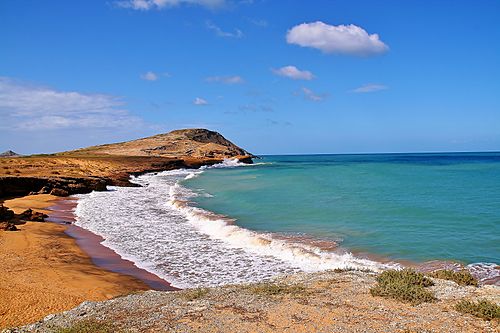
See also
 In Spanish: Hernán Pérez de Quesada para niños
In Spanish: Hernán Pérez de Quesada para niños


